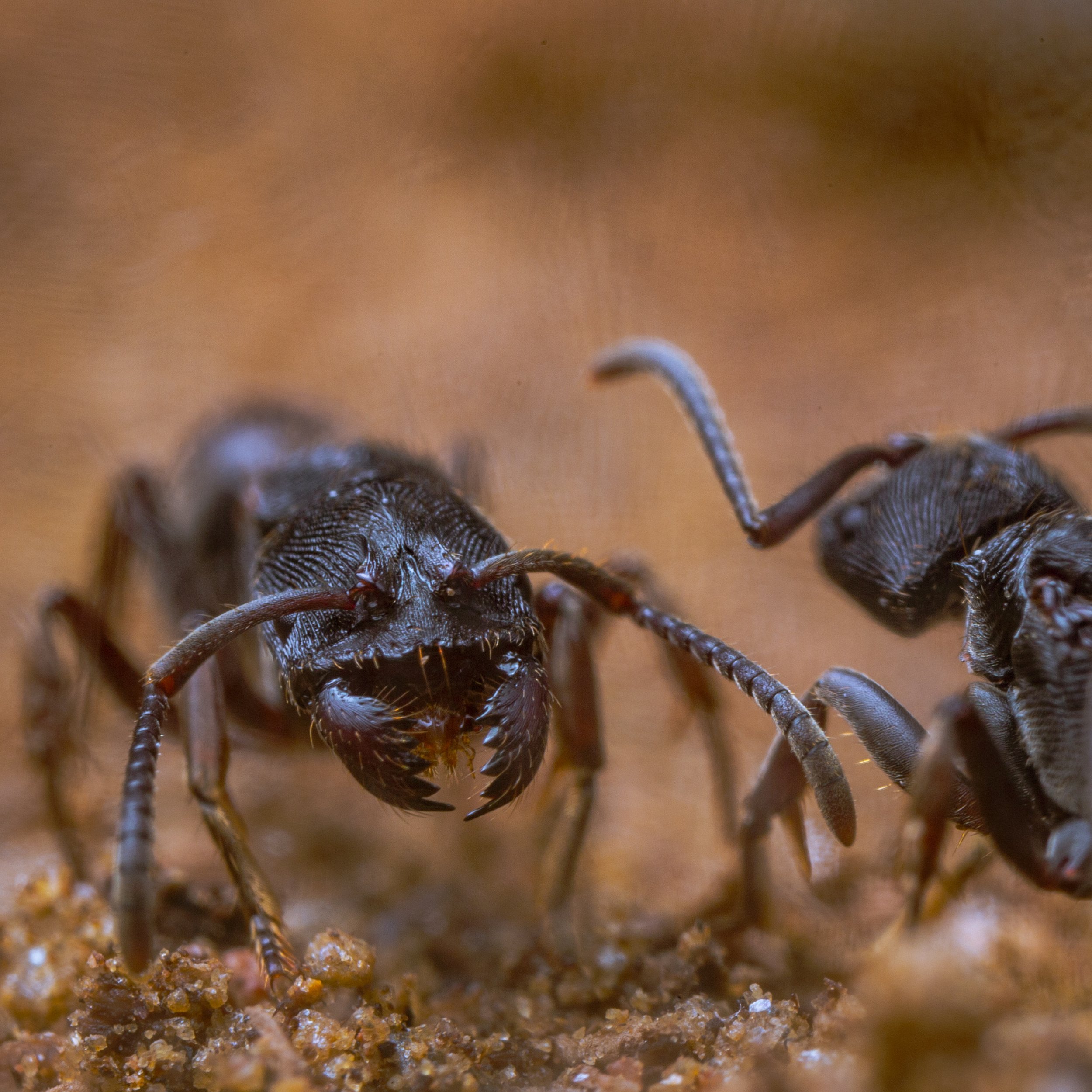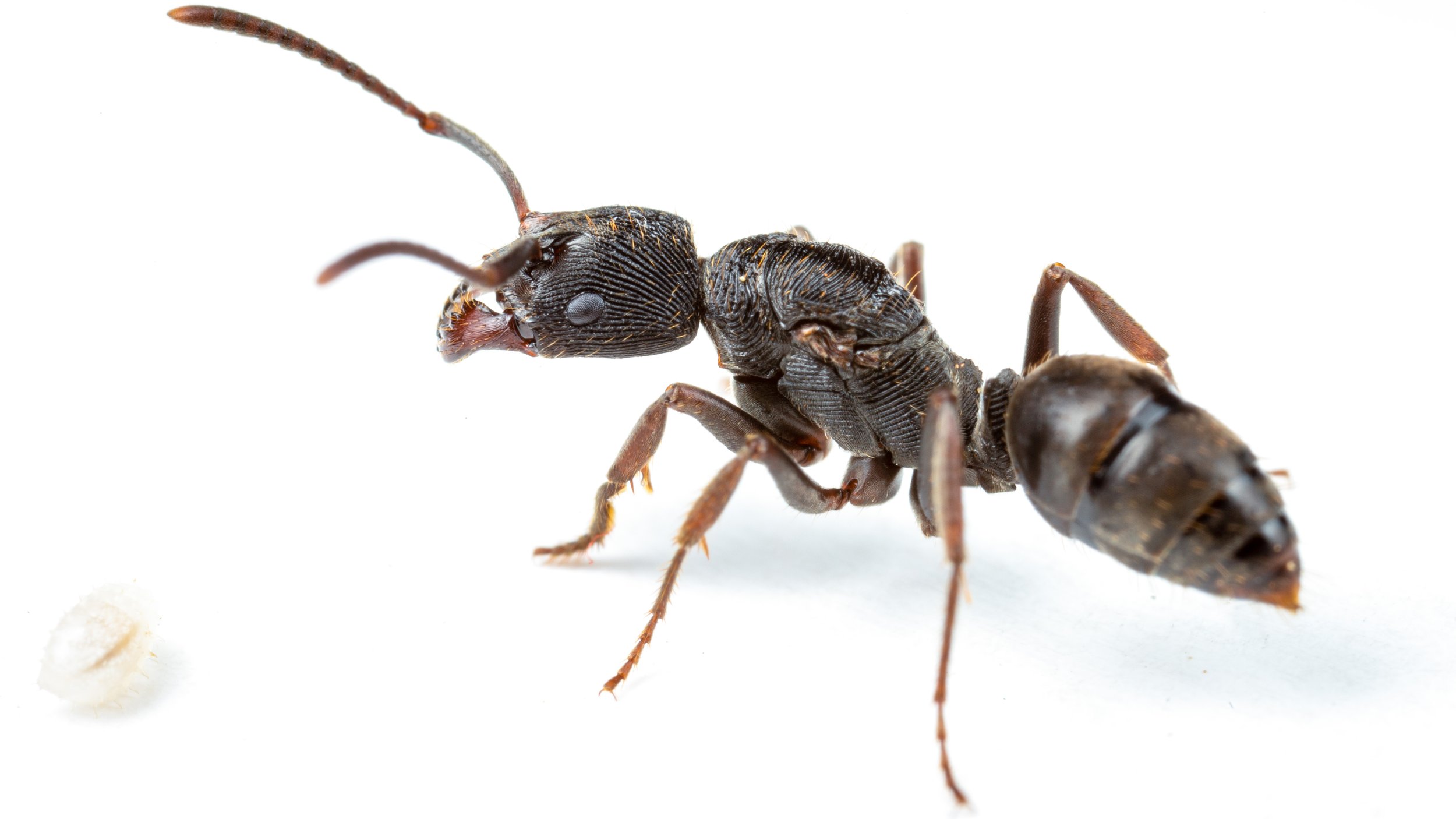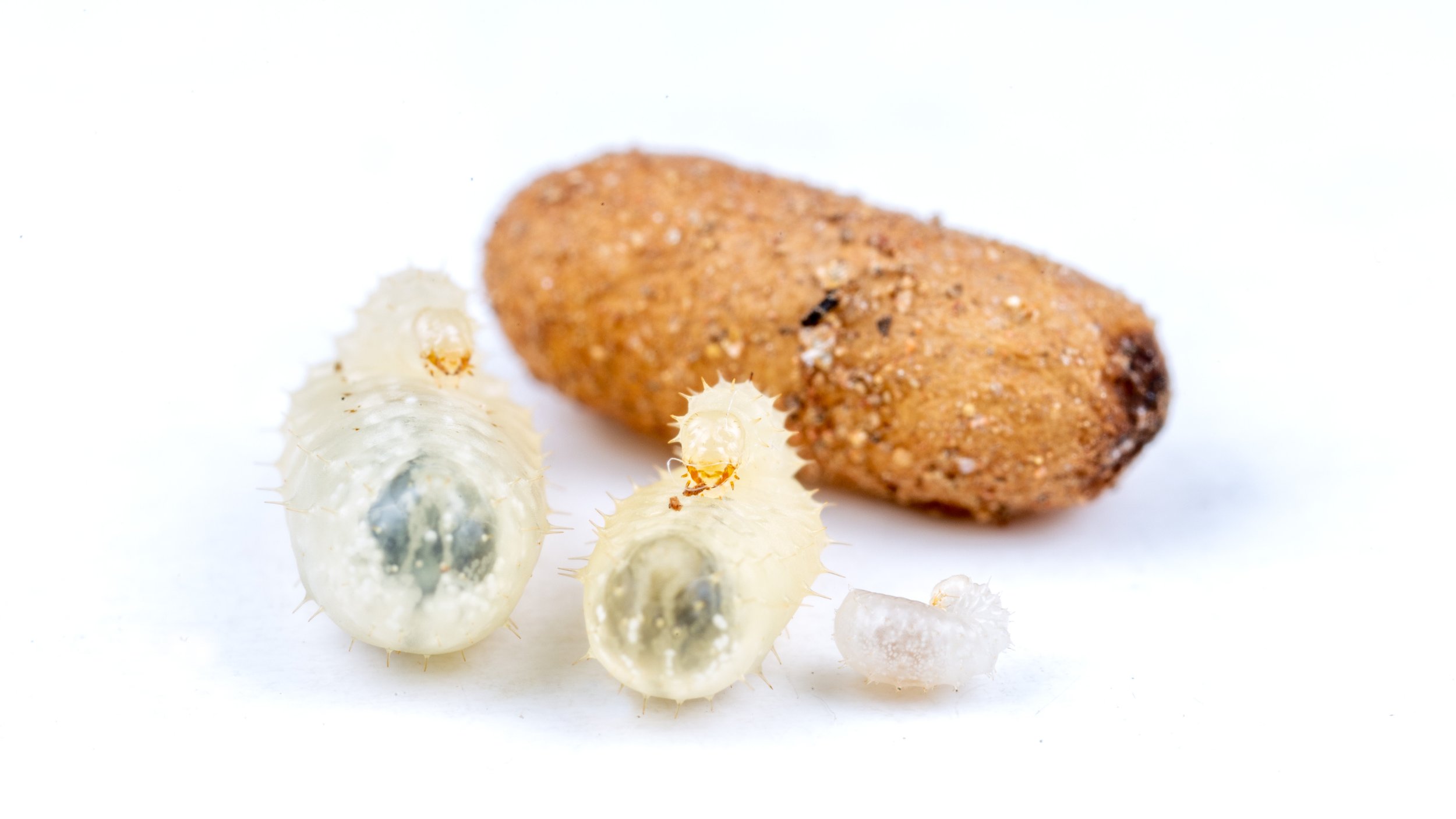Odontoponera - Care Guide and Ecology
INTRODUCTION
Odontoponera is one of the most widespread ponerine species, it's your typical Asian Ponerine.
Odontoponera Queen
Ponerine ants are one of the most fascinating subfamilies of ants you can keep, for they combine simple social organization with a high diversity of morphological, ecological and behavioral traits.
SUB FAMILY / GENUS
Odontoponera was first recognized as a distinct genus in 1862 by Mayr, an ant species which was described a year earlier by Frederick Smith as Ponera denticulata.
This insect was later found to be identical with Smith’s Ponera transversa described in 1857. The name denticulata was, therefore, replaced by transversa, this was the starting point of subsequent long-lasting confusion. After the necessary corrective revisions.
The genus of Odontoponera currently contains two species, one of which has three subspecies.
O. denticulata
O. transversa
O. transversa biconcentrica
O. transversa infuscata
O. transversa nitens
MORPHOLOGY
They are medium sized ants, workers spanning from 9 to 12 mm, queen ranging from 11 to 13mm. They have short and strong mandibles, short legs, cannot climb smooth surfaces and vary from dark red to black. They possess a stinger.
Odontoponera worker
The mandibles contain some of the most important diagnostic characters in ponerine taxonomy and provide a wealth of insight into the ecological niches of the ants that use them. Although the ponerinae are ancient and very primitive, they comprise, nevertheless, the genera or subgenera in which the mandibles are highly specialized and differ from those of most formicids in having elongate often more or less linear blades, with few or unusually modified teeth or other structural peculiarities, and in the case of Odontoponera, can be differentiated from other ponerines by their denticulate anterior clypeal margin.
Odontoponera mandibles
They have other interesting characteristics such as, toothed pronotal margins, these side spikes on their thorax, and the strong striate sculpturing of Odontoponera is also very characteristic (the fingerprint pattern), though other Ponerine ants like Diacamma and Ectomomyrmex also have striate sculpturing.
COMMON NAME
Hence their common name Tooth Ponerine Ants.
DISTRIBUTION
Odontoponera range stretches from Pakistan all the way to the Philippines and from Southern China to the islands of Southern Indonesia.
Antmaps.org Odontoponera worldwide distribution
In countries such as Pakistan, India, Bangladesh, Myanmar, Thailand, Malaysia, Indonesia, Philippines, Cambodia, Vietnam, Laos, South China and Taiwan.
One of the most widespread ant genus in the all sites surveyed was Odontoponera (78% of the times), they can be found in urban areas (within a structure/building perimeter and outdoors), agricultural areas (plantations), and natural forests, both mixed deciduous and the dry dipterocarp forests, possibly due to its aggressiveness, carnivorous and scavenger habits.
HABITAT
In much of Tropical South China, where I am located, there is no lowland primary forest consequently secondary forests are the most common of habitats, and here is where you can easily find Odontoponera.
Lowland primary forest trail
Ants occupy 10% or more of the total terrestrial animal biomass in tropical rainforest and in the other major biomes, and play an important role in energy flows and biomechanical cycles as predators of soil invertebrates, and scavengers, and soil-mixing agents. As such, every aspect of foraging, foraging site, food preference, daily activity or foraging range is important, and should not be ignored.
NESTING PREFERENCES
Odontoponera nest entrance
Odontoponera are a ground dwelling type of ants. They are highly adaptable and can nest in various environments but their preference is for forested areas, where they will nest either on the ground or on the embankment slopes. It is estimated to exist between 0.58 to 1.25 Odontoponera nests on each square meter of primary and forest area.
Their nest entrances, which are mostly circular, varying in diameter from 3.5 to 5 mm. Each entrance can only accommodate one worker ant, either entering or exiting. There are no ant hills associated with the nests of this species.
Odontoponera worker protecting its nest entrance
Regardless of whether it is built on flat ground or on a slope, Odontoponera colonies usually have only one nest. The nest is a series of horizontal chambers stacked on top of one another. Each chamber height is generally 5 mm, and a few can reach 15 mm; regarding the width varies between 13-68 mm. The entry point’s slender connection tunnels branches out and extends deep into the soil. They are connected to the main nest chambers at different depths.
Odontoponera nest entrance and longitudinal view
The uppermost nest chamber depth varies between 97-365 mm from the ground surface, and the lowest nest chamber is located between 110-575 mm from the ground surface.
Queens and larvae usually live in lower chambers, and workers are scattered in the upper nests.
Odontoponera eggs and 1st instar larvae
FOOD PREFERENCES
Odontoponera workers are predominantly epigeic, which means, above the ground, solitary foragers and are generalist predators and scavengers. While the chief enemies of ants are other ants, the fiercest and most implacable enemies of termites are not other termites, but ants as well. Odontoponera is especially fond of termites and is often seen raiding their colonies, but being generalist scavenger and predator, ants and termites made up nearly half of the food items collected by Odontoponera workers.
Odontoponera collecting a water droplet in its mandibles
Termitharpagy, the termite raiders among ants may be divided into two groups, the obligatory and the facultative. The former feed exclusively on termites and are all Ponerines, whereas the latter prey also on other insects and comprise Dorylines and Myrmicines as well as Ponerines.
FORAGING & RECRUITMENT
Workers are known to forage at lengths of 1.16m outside the nest, which is one of the furthest foraging lengths for exclusive ground foraging ants in Asia. Odontoponera is, however, a species known to have a horizontal network with several nest entrances, thus the real foraging distance of Odontoponera may be much longer when considering underground galleries.
The predatory efficiency and the use of interconnected nest entrances probably enable these fast-moving Odontoponera species to take hold of new feeding opportunities faster than any other direct competitor species. Being one of the most dominant and widespread species means that fewer resources are distributed to other competitor species.
In observing its foraging and feeding behavior in a particular experiment with fruit flies larvae in the vicinity of their nests, due to decomposition of animal or fruit matter, the Odontoponera workers show more interest in mobile than static larvae during their first encounters. As time passed by, foragers were seen becoming more and more aggressive, snatching both mobile and static larvae, indicating that experience such as learning and memories are an important part of the foraging and hunting patterns of Odontoponera species.
Odontoponera are considered to be diurnal ants starting their first activity cycle around 4am, peaking at 15pm and stopping all external activity at 18pm.
CASTE DIMORPHISM
Colonies of the typical ponerine contain a few dozen to a few hundred adult workers and a single or few dealate queen(s). Workers are monomorphic. The queen is morphologically similar to the workers except for its larger eyes, ocelli, modified thoracic flight sclerites (what we call wing scars), and enlarged gaster. Workers retain ovaries and spermatheca and may lay haploid eggs, which will turn out to be males only.
Odontoponera male
Colony emigration occurs via social carrying and through the use of weak chemical orientation cues.
Division of labor among the workers follows a typical pattern of age differentiation, with younger workers performing nest duties and older workers foraging. Trophallaxis does not occur between adults or between adults and larvae, as such prey is fed directly to the mandibulate larvae. Pupae are enclosed in cocoons.
REPRODUCTIVE STRATEGY
In ants, dispersal strategies and morphology of female sexuals are generally linked to the mode of colony founding. In species using long-range dispersal tactics, queen/worker dimorphism is generally high and young queens are able to initiate new colonies by themselves, using their metabolic reserves. By contrast, in species using short-range dispersal strategies, queen/worker dimorphism is generally low and, due to their limited metabolic reserves, queens have lost the capacity to raise their brood alone and to found their colony independently. Moreover, polygyny is also often associated with short-range dispersal strategies, although the relationship between the number of queens and the dispersal strategy in ants is not clear.
In the case of Odontoponera, queens adopt Independent Colony Foundation with possibility of polygyny. Having weak queen-worker divergence, small flight muscles and their histolysis is evidently not a sufficient source of amino acids for the developing larvae, the queens need to forage outside their shelter at regular intervals to feed the first generation of larvae. Furthermore, ponerine larvae cannot be fed by regurgitated secretions, and instead they eat some of the queen’s eggs or pieces of prey brought into the nest.
Two Odontoponera queens founding together
Semiclaustral ICF is linked with poor success rates due to the risks of brood parasitism and predation on foraging queens.
In the typical thorax of modern flying insects, the first segment (T1) bears no dorsal appendages, while the second (T2) and third (T3) each bear a pair of wings. In workers, T1 is more developed than T2, and T3 is mostly absent in workers of many species. While in queens, T1 and T2 will vary according to the foundation strategy. In the case of Odontoponera, the ratio T1/T2 in queens measures 0.524. In the case of claustral queens the ratios vary from 0.072 to 0.132 where as in non-claustral varies from 0.282 to 0.558 (from all the studied cases).
My Odontoponera’s Keeping Experiences (an Ant Keeper’s Guide)
Recommendations for foundation stage:
Assuming that you captured new de-alate queens, before you even introduce them to their nesting chamber, give them a feed a large drop of honey water. Let them drink as much as they want, while you end up preparing their nests.
I recommend having either a test tube with soil (precaution on the soil touching the water reservoir cotton, as it can get saturated by absorbing too much water through the cotton, so use something to act as a soil stopper) or plaster with soil acrylic nest. I personally prefer the second option, as i feel more control, since they cannot climb, i rather have the possibility of opening the top lid and accessing the nest if i need to.
If you found multiple queens keep them together in groups of 2 or 3 queens per nest. And after you introduce them to the nest, close it off for 2 days. Let them stay inside and mark it with their pheromones. The queens will have a dominant queen while the others will serve more as queen workers.
If you just found one, it's the same process, the only difference is that she will do all the work.
Meanwhile prepare an outworld with bone dry soil, a honey water dish and a water dish.
After a couple days, you can open the connection between the nest and the outworld.
In my personal experiences with Odontoponera queens, I avoid giving them any insects until they have larvae. I notice the foreign smells through them into panic mode. But I know many keepers who do and still have great success. I rather stick to honey water.
In principle it should take one to two weeks for the queen(s) to lay their first egg. After the first egg, they should lay 4 or 5 more, and that should be your first generation.
This is the moment where you need to be patient but keep a close eye on their development. As soon as you see those eggs developing into mini larvae, it's time to give the queen's their first protein. I like to use freshly crushed fruit flies, or freshly killed baby crickets or roaches, something that is small and easy for the queen to transport inside the nest. You want to have soft body insects, to make their feeding easier. You can use mealworms, but if you do my recommendation is to cut them into pieces, and offer one piece first.
As it was written previously, mealworms aren’t part of their diet in the wild, and the queens probably never smelled anything like it before, and queens tend to be very bad huntresses, so you need to understand that and have some patience and perseverance.
If all goes well, you will see the larvae getting plump and keep their white coloration, and then one day, you will either see them pupating, or already in pupae stage.
After a couple more weeks, you should have your first workers, and the colony should be off in a good direction. After those workers appear, you can start increasing the amount of protein, for they will be more active hunters.
Now for the things that can go wrong, and with this species, many things can go wrong, and simply don’t make any sense.
No matter how hard you try, some queens just end up dying in a period of few days, and it doesn’t necessarily mean that it was your fault, it's just as life is. So don’t beat yourself too much over their deaths.
Queens will eat their eggs. This can happen on two separate occasions. First occasion is when the queen just started to lay her first batch of eggs, and a few days later they are gone. Well, this is either because of stress (too much light, or vibration) or because she is starving (don't force food inside the nest, she will come outside to feed, just make sure she has available food and water). The second occasion is when the queen already has her first batch of larvae developing and she lays her second batch of eggs, and a few days later, the eggs are all gone. Well this is nothing to be worried about, many queens will continue to metabolize their energy reserves into the production of trophic eggs to feed the larvae. Most of these eggs wouldn’t be viable either, so don’t worry too much. The queen is more focused on getting her first generation of workers than her second.
Larvae have puppated successfully and the queen suddenly opens the pupae ahead of time and consumes it. Honestly, I don’t know why this happens, but it seems to happen quite frequently, and it can happen for a very long time. This has happened to me for a period of over 3 or 4 months. I was always waiting for that first worker to eclose, and the queen would simply open up the pupae and munch it up, to feed the other larvae. At one point, finally the first worker managed to eclose and this behavior seemed to have stopped, just seeing it happening again in 5% of the pupae. My recommendation is to avoid as much as possible disturbing the nest or queen, and trust nature, in the end they will make it through.
If you get multiple queens in the same nest, after the first workers show up, you can wake up one day and have either a dead queen on the outworld or a queen roaming the outworld, that means that she was evicted. It's better to observe her behavior for 1 day, and in case she doesn’t go back inside, then its confirmed she was evicted, and you can remove her, and try to start a new colony with only her. If you force her inside the nest again, she may end up killed. Sometimes, multiple queens seem to stay together even the birth of their first generation without any apparent aggression which is awesome.
Regarding temperatures and humidity, they like above 25C, but still maintain active until 18C. And humidity at 70% to 90% is best. If you are able, you can saturate (flood) a corner of the nest, and you will be able to see the larvae and colony drinking on their own. Once every two months, I like to do this. It increases the humidity inside the nest a lot, and you see all the colony having a drink. I always provide water on the outworld, but because they don’t perform trophallaxis, I am not exactly sure if sufficient water is getting to the non foraging workers. Note: don’t do this if you have a garbage pile inside your nest! It will only help grow mold and fungus. Don’t forget that these ants have staggered chambers in the wild, and they can simply move up and down according to their needs, but in your nest, most probably they are confined to one chamber.
When to find the Queens?! You can refer to my videos and see which type of surroundings I find my queens in.
Tooth Ponerine Ants, a complete overview
Hope you found this article interesting and useful. Let me know if you have any particular questions or comments, I will make sure to answer them all !
















